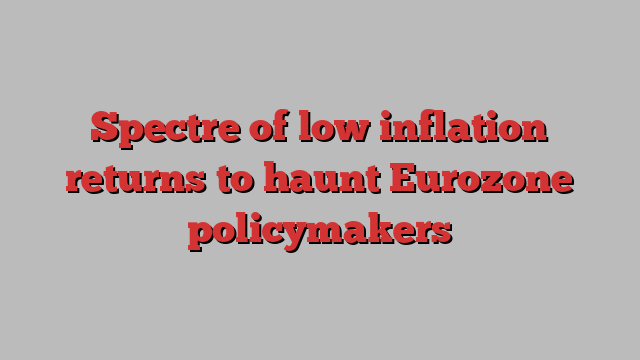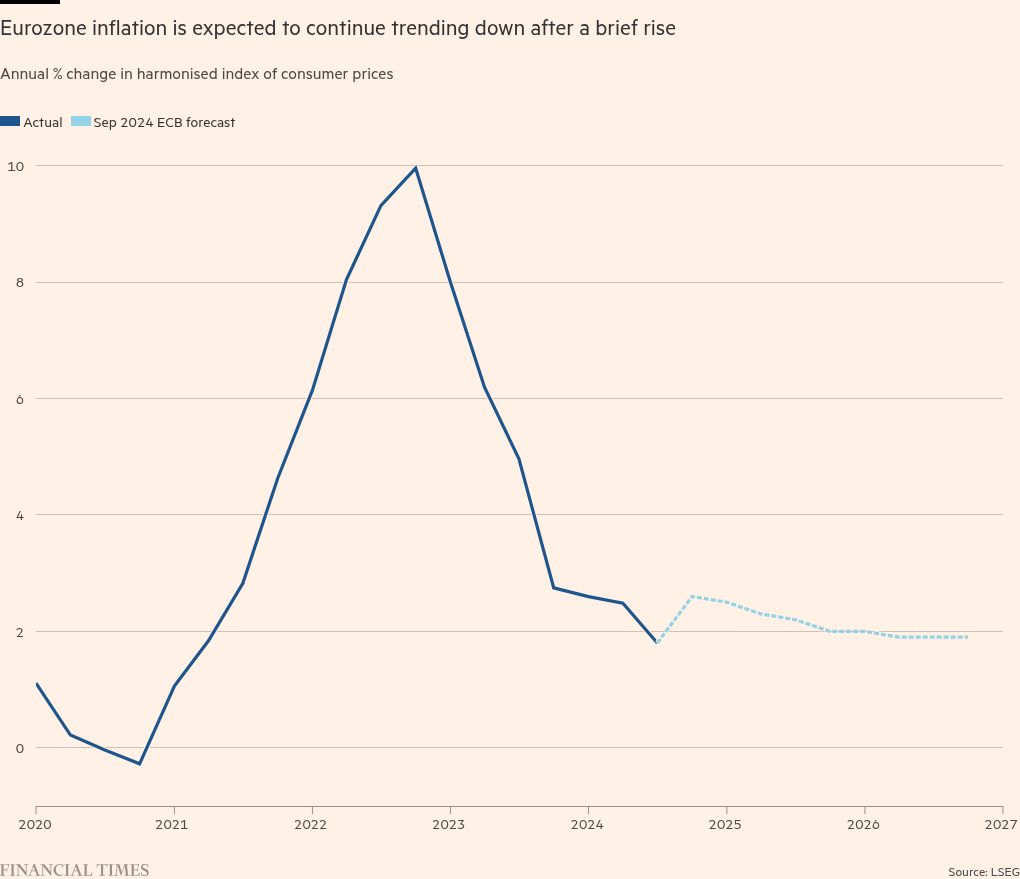
Unlock the Editor’s Digest for free
Roula Khalaf, Editor of the FT, selects her favourite stories in this weekly newsletter.
The Eurozone’s weak economic growth and sluggish consumer price rises have raised concerns that the European Central Bank may be facing the threat of too little rather than too much inflation, economists have warned.
The prospect of a bout of reduced price rises is a sharp turnaround from recent historic levels of high inflation, which forced the ECB to push interest rates up to a record 4 per cent in September 2023.
Monetary policymakers will meet this Thursday and are widely expected to reduce rates. Having previously not anticipated a cut until December, investors now view a quarter-point reduction to 3.25 per cent as a given.
The October cut could usher in a series of faster and steeper reductions in borrowing costs in an effort to stop inflation from persistently undershooting its target, economists said. Financial markets are now pricing in that the ECB will lower rates to just 1.7 per cent by the second half of next year. In September, annual inflation fell to 1.8 per cent, putting it below the ECB’s 2 per cent medium-term goal for the first time in more than three years.
“Avoiding a fall back into the pre-Covid world [of inflation below 2 per cent] will be one of the ECB’s biggest challenges,” said Jens Eisenschmidt, chief Europe economist at Morgan Stanley, who until 2022 worked at the ECB. He predicts the ECB’s key deposit facility rate will have halved to 1.75 per cent by December 2025, but added: “It is very well possible that this level will not be the end [of the easing cycle].”

Historically, too little rather than too much inflation had been the ECB’s bigger problem. In 93 of 120 months to July 2021, when the recent surge in prices began as demand rebounded during the pandemic, inflation was lower than the ECB’s goal. The 2 per cent target was introduced that summer.
It replaced a more conservative goal of inflation being “below, but close to 2 per cent”. To stop further falls in inflation, the ECB embarked on an unconventional monetary policy, inflating its balance sheet through bond purchases and pushing its key interest rates into negative territory.
Minimal price increases increase the danger of falling into deflationary territory, which can trigger a self-reinforcing downward cycle as consumers postpone purchases while shrinking income makes it harder to pay down debt. Overcoming deflation can be much harder for central banks than reining in inflation.
For now, the latest ECB staff forecasts predict that annual inflation will hit its 2 per cent target in the fourth quarter of 2025 and stay well above that level over the first nine months of the year.
But central bank officials were concerned that the forecast, which was published in September, might be too rosy even before the month’s annual 1.8 per cent inflation figure was published. According to the minutes of the September meeting, rate-setters noted that “the risk of undershooting the target was now becoming non-negligible”.
Yannis Stournaras, governor of the Bank of Greece, said this week the most recent data “suggests that perhaps we get to 2 per cent in the first quarter of 2025”.
This is despite an expected temporary rise in headline numbers by the end of the year. Due to a statistical quirk, the year-on-year comparison in November and December will be distorted upwards as oil prices in the final months of last year fell temporarily.
But the ECB “will see through that”, said Bill Diviney, ABN Amro’s head of macro research.
As wage rises in leading Eurozone economies respond with a time lag to the past surge in inflation, headline inflation numbers next year are also expected to be higher than the more feeble underlying economic dynamics would suggest, said one person familiar with the thinking of a member of the governing council.
“In the short term, the weak growth outlook is the more critical factor but the risk of undershooting [the 2 per cent inflation target] is already part of the equation,” the person said.
ECB president Christine Lagarde said last week that the central bank would take into account increasing confidence that the ECB’s medium-term inflation target was in touching distance, a remark that increased investors’ expectations of a rate cut.
Yet Sebastian Dullien, research director of Düsseldorf-based Macroeconomic Policy Institute, said weak growth and sharply falling inflation suggested that the ECB “is acting too slowly [on adjusting rates] once again”, adding that the central bank’s analysis of the drivers of inflation was “flawed”.
Dullien argued that the inflationary surge between 2021 and 2023 was a temporary one driven by higher energy prices and supply chain bottlenecks rather than a fundamental rise in demand. He said the ECB increased interest rates too much, harming an economy that was already hit by low productivity, tepid investment and an ageing population.
“The overly restrictive monetary policy exacerbated some of the structural issues,” Dullien added.